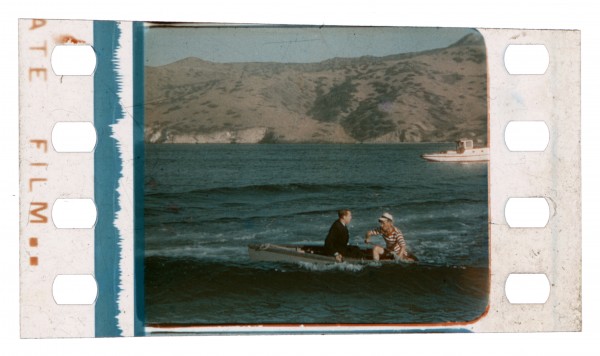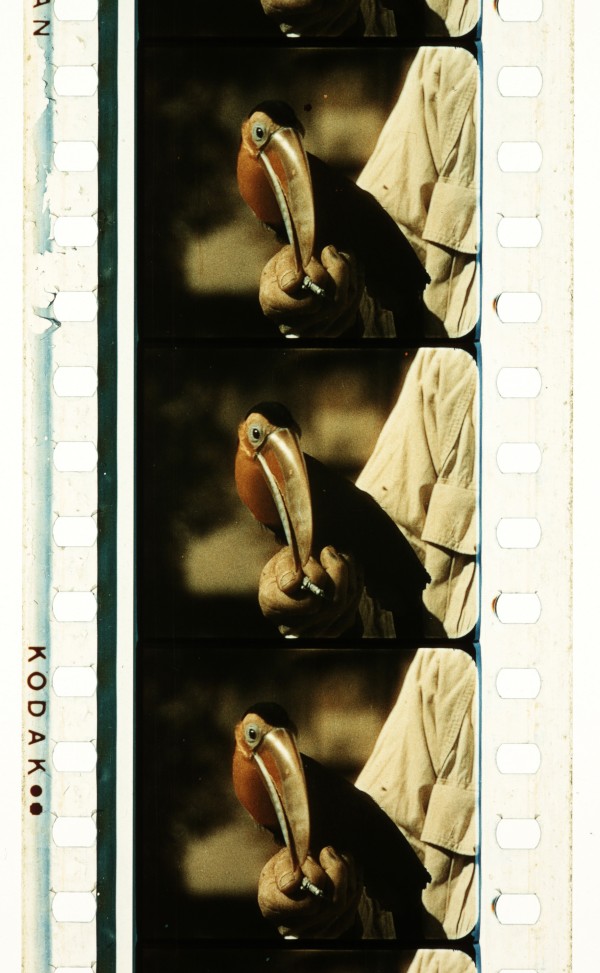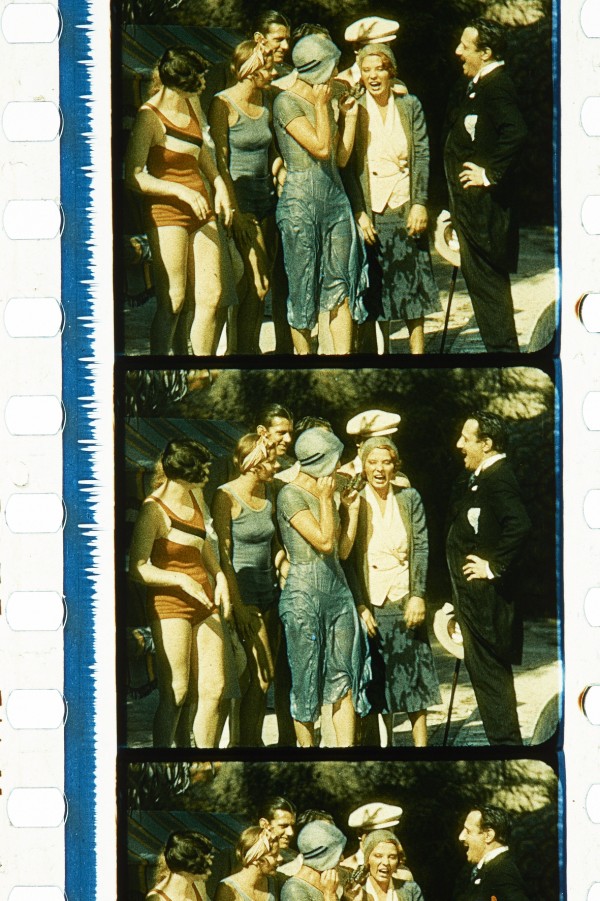Film Explorer

A frame from a 35mm Sennett-Color print of The Bluffer (1930) featuring Lincoln Stedman and Andy Clyde.
Film Frame Collection, Seaver Center for Western History Research, Natural History Museum of Los Angeles County, Los Angeles, California, United States.
Identification
History
From an early stage, comedy producer Mack Sennett actively explored the use of natural color. After a first test with Technicolor’s two-color process #2, filmed on April 24, 1926 by a Sennett crew headed by director Del Lord, sequences in Technicolor #3 filmed by Ray Rennahan were inserted into eight two-reel comedies featuring the Sennett Bathing Girls, released between December 1927 and May 1929. Inspired by the novel possibilities of color, Sennett then reverted to the more affordable Multicolor process for the production of Jazz Mamas (Mack Sennett, June 1929), advertised as the first “all-talking, all-color, singing, dancing comedy”. For this musical comedy, Sennett technicians Paul Guerin, Arthur Blinn and cameraman Billy Williams collaborated with Multicolor inventor William T. Crespinel to shoot the film at Sennett’s new, state-of-the-art soundstage in Studio City, fully equipped and licensed for the RCA Photophone system since October 1928.
With all the technical expertise and facilities in place, Sennett then tried his hand at a natural color process under his own name. This research was facilitated by several key developments in the industry, including the special dye-filtered negative for bi-pack filming developed by Eastman Kodak, and the commercial availability of duplitized (double-coated) film from Agfa, Kodak and Dupont. After more than six months of testing, a huge investment in a color laboratory with printing machines and a chemical room, and the salaries for the cast and crew of an unsuccessful test film (Bulls and Bears, March 1930, filmed in color but released in B/W), Sennett was finally able to release Radio Kisses (May 1930) with sequences in Sennett-Color. Around the same time, Sennett’s chief technician Paul Guerin filed a patent application for a contact printer with two light sources on either side of the film gate, to enable printing on two sides of double-coated film. (Guerin, 1930)
In the time span of little over one year, between September 1930 and November 1931, Sennett produced at least eight shorts in Sennett-Color: six one-reel Mack Sennett Brevities and two two-reel comedies. These full-color, talking comedies explore the increased realism of color and sound for comic effect. Citing the tagline “nature’s reflection”, Sennett-Color was mainly used to display nature’s novelties, capturing the hues and shades of fauna and flora. The stories were filmed on colorful locations and structured like guided tours, touristic visits, or kid’s field trips, picturing comic encounters with specific species, places, and attractions. The typical aesthetics of a Mack Sennett Brevity short can be summed up as: nature’s colorful subjects pictured with color fidelity and synchronized with naturalistic sounds accompanied by expert explanations and songs.
From the start, Sennett made the Sennett-Color process available to the entire industry, reinstituting a dormant corporation and renaming it Mack Sennett Color Film Company, Ltd., on May 22, 1930. (Walker, 2010: p. 192) Trusting the potential of Sennett-Color to attract commissioned films, the company grouped all the assets that were of interest to commercial clients in an Industrial Film Division helmed by General Sales Manager C. W. McCann. This division offered the use of Sennett’s license for the RCA Photophone sound system, the Sennett-Color process, the state-of-the-art sound stages and other studio facilities in Studio City to outside producers in theatrical and nontheatrical circuits. The studio in fact proposed to operate as a service center to try tapping into extra channels of revenue. Still, only a handful of mostly poverty-row producers came forward and by the end of 1931 it had become clear that the continued investment in a minor two-color process like Sennett-Color was not financially viable. By the time the patent application was granted in 1932, all color activities had ceased and the color lab was dismantled in June 1932.
The end of these color activities heralded the studio’s continued demise. Following cashflow problems that had been building up during the early Depression years, the investments for studio and sound equipment, overdue income from rentals, and the bankruptcy of distributor Paramount Publix Corporation, Mack Sennett Inc. saw no other option than to file for bankruptcy on December 12, 1933.

Toucan filmed in the bird park that had recently opened on Santa Catalina Island in Strange Birds (1930).
Collections of the Library of Congress, National Audio-Visual Conservation Center, Culpeper, VA, United States. Photograph Hilde D’haeyere.

Virginia Whiting, Marjorie Beebe, Luis Alberni and women water polo players for Movie-Town (1931). Virginia Whiting’s dress just changed color from Sennett-Color red to Sennett-Color blue after her dive into the studio swimming pool. This is the only salvaged piece of a decomposing nitrate print.
Collection of The Internet Archive, San Francisco, CA, United States. Photograph Hilde D’haeyere.
Selected Filmography
Mack Sennett Brevity: One-reel comedy in Sennett-Color which survives complete on 16mm, including an underwater kiss and a blushing fish. It was re-issued in color in 16mm and 8mm by Thunderbird Films (Tom Dunahoo) in the 1970s.
Mack Sennett Brevity: One-reel comedy in Sennett-Color which survives complete on 16mm, including an underwater kiss and a blushing fish. It was re-issued in color in 16mm and 8mm by Thunderbird Films (Tom Dunahoo) in the 1970s.
Mack Sennett Brevity: A one-reel fishing trip comedy in Sennett-Color, not known to survive.
Mack Sennett Brevity: A one-reel fishing trip comedy in Sennett-Color, not known to survive.
Mack Sennett Special: A cross-country race, featuring beautiful landscapes filmed from an airplane. The two-reel comedy is not known to survive in Sennett-Color, although a B/W print exists.
Mack Sennett Special: A cross-country race, featuring beautiful landscapes filmed from an airplane. The two-reel comedy is not known to survive in Sennett-Color, although a B/W print exists.
Mack Sennett Brevity: A nitrate color print of this one-reel comedy survives in full, featuring a tour of the bird aviaries on Santa Catalina Island.
Mack Sennett Brevity: A nitrate color print of this one-reel comedy survives in full, featuring a tour of the bird aviaries on Santa Catalina Island.
Mack Sennett Brevity: A nitrate color print of this one-reel comedy survives in full, filmed on and around Lake Arrowhead.
Mack Sennett Brevity: A nitrate color print of this one-reel comedy survives in full, filmed on and around Lake Arrowhead.
Mack Sennett Brevity: A one-reel comedy filmed in a speed boat and airplane, featuring the actual World Speedboat Champions Loretta Turnbull and Harold Ferguson. Not known to survive.
Mack Sennett Brevity: A one-reel comedy filmed in a speed boat and airplane, featuring the actual World Speedboat Champions Loretta Turnbull and Harold Ferguson. Not known to survive.
Mack Sennett Brevity: One-reel comedy featuring a tour of Luna Park Zoo (former Selig Zoo) in Los Angeles. Only survives as a B/W print.
Mack Sennett Brevity: One-reel comedy featuring a tour of Luna Park Zoo (former Selig Zoo) in Los Angeles. Only survives as a B/W print.
Technology
Modeled on the Multicolor process, Sennett-Color used commercially available film stocks for bi-pack filming and double-coated printing, as well as known formulas for toners. Principal photography recorded images on bi-pack negatives: two film strips with their emulsion surfaces in contact, running together through the camera gate. With one film acting as filter for the other, each negative recorded a particular part of the color spectrum. The upper film, being orthochromatic, was sensitive to blue and green light only, recording the according elements. The remaining light was transmitted to the underlying panchromatic film, exposing the red record. After development with a regular B/W developer, the negatives were printed on both sides of double-coated positive film. The B/W images were colored blue-green with an iron toner on one side, and orange-red with a uranium toner on the other. As a Sennett-Color print carried its color components on both surfaces, each emulsion layer was sealed with a protective varnish to prevent scratching.
While Multicolor was constructing a new plant in Hollywood during the summer and fall of 1930, Sennett’s technical director Paul Guerin took advantage of a patent gap to file applications for a slightly adapted camera gate on the Sennett studio’s Bell & Howell 2709 cameras and a dedicated printing machine. On May 9, 1930, patents for a “printing machine for multi-color printing upon a single positive film stock” as well as a punch device to ensure the accurate alignment of several image strips were filed (Guerin, 1930). In that printer, the two-color component negative films were loaded on either side of a double-coated positive film, then the three films moved in a fixed relation to each other past the light aperture, simultaneously exposing the negatives on opposite sides of the positive film.
Compared to Multicolor prints, the blue tone in Sennett-Color prints contains more green than Multicolor’s cobalt-like blue, and the red tone is a dirtier orange than Multicolor’s scarlet-like red. Inspection of surviving prints suggests that Sennett-Color prints are more transparent with a softer and cooler appearance than the brilliant colors of Technicolor’s dye-imbibition prints. Sennett-Color also allowed more production flexibility than the proceedings with Technicolor, since color scenes were filmed by the regular, slightly adjusted B/W studio cameras operated by an in-house crew. The processing was done economically in the studio’s laboratory that delivered color dailies within 24 hours, resulting in very short post-production periods. One of the feats showcased in several Sennett-Color shorts is underwater photography, featuring even, in The Bluffer, a color joke in which a fish blushes to a deep red when witnessing an underwater kiss.
The launching of Sennett-Color was received favorably in the professional and popular press. Edwin Schallert of the Los Angeles Times reported a “subdued quality to this color” that “does not distract” despite “a certain blotchiness” (Schallert, 1930, p. A7), while Hynes in Motion Picture News declared the colors “unusual in the realistic effects obtained” (Hynes, 1930, p. 6), and the Journal of the Society of Motion Picture Engineers remarked that the underwater photography looked "quite natural." (Anon., 1930b, p. 792). In 1931, a reporter in the Motion Picture Herald noted “a constant improvement in each release” (Anon., 1931, p. 46).
References
Anon. (1930a). “Report of Color Committee May 1930”. Journal of the Society of Motion Picture Engineers, 15 (December): pp. 721–722.
Anon. (1930b). Journal of the Society of Motion Picture Engineers, 15:6 (December): p. 792.
Anon. (1931). Motion Picture Herald, April 18, 1931: p. 46.
Cornwell-Clyne, Adrian & Klein, Bernhard (1940). Colour Cinematography (2nd rev. edn), pp. 218–219. Boston: American Photographic Pub. Co.
Cornwell-Clyne, Adrian (1951). Colour Cinematography (3rd rev. and enlarged edn). London: Chapman & Hall, p. 342.
D’haeyere, Hilde (2012). “Technicolor-Multicolor-Sennett-Color: Natural Color Processes in Sennett Slapstick Comedy Shorts 1926–1931”. In Brown, Simon, Sarah Street & Liz Watkins, Color and the Moving Image. London: Routledge: pp. 23–36.
D’haeyere, Hilde (2018). “Ziegfeldized Slapstick, Useful Comedy: Mack Sennett’s Comedies under the Influence of Natural Colour”. In Fossati, Giovanna, B. G. Lameris, Victoria Jackson, Joshua Yumibe, Sarah Street & Elif Rongen-Kaynakci, The Colour Fantastic: Chromatic Worlds of Silent Cinema. Amsterdam: Amsterdam University Press, pp. 125–144.
Guerin, P. J. for Mack Sennett Color Film Co. Ltd. (1930). Printing Machine for Cinematograph Films, US Patent 1,880,087, filed May 9, 1930, patented September 27, 1932.
Hynes, Bernard J. (1930). “Good Color”. Motion Picture News, October 25, 1930: p. 6.
Ryan, Roderick T. (1977). A History of Motion Picture Color Technology. London: Focal Press.
Schallert, Edwin (1930). “Cast Good in New York Narrative”. Los Angeles Times, May 17, 1930: p. A7.
Walker, Brent E. (2010). Mack Sennett’s Fun Factory. Jefferson, NC: McFarland & Company Publishers.
Patents
Guerin, P. J. for Mack Sennett Color Film Co. Ltd. 1930. Printing Machine for Cinematograph Films, US Patent 1,880,087, filed May 9, 1930, patented September 27, 1932.
Related entries
Author
Hilde D'haeyere is a photographer and film historian who investigates photographic aspects of cinema. Much of her work is on film style, movie technology, and the mechanisms of humor, with a particular focus on silent slapstick comedy and early color strategies. As well as working as photographer of art and architecture, she currently lectures at the Royal Academy of Fine Arts (KASK), school of arts at the University College Ghent, Belgium, where she heads the master's program in film.
Immense thanks to the following people for making the rare and fragile color materials available for research: George Willeman and Mike Mashon, Library of Congress, Packard Campus, Culpeper, VA; May Haduong and Melissa Levesque, Academy Film Archive, Los Angeles, CA; Rick Prelinger, The Internet Archive, Richmond, CA; to slapstick scholar Brent Walker for all things Sennett; and to James Layton for sharing his ever expanding expertise.
D'haeyere, Hilde (2024). “Sennett-Color”. In James Layton (ed.), Film Atlas. www.filmatlas.com. Brussels: International Federation of Film Archives / Rochester, NY: George Eastman Museum.


